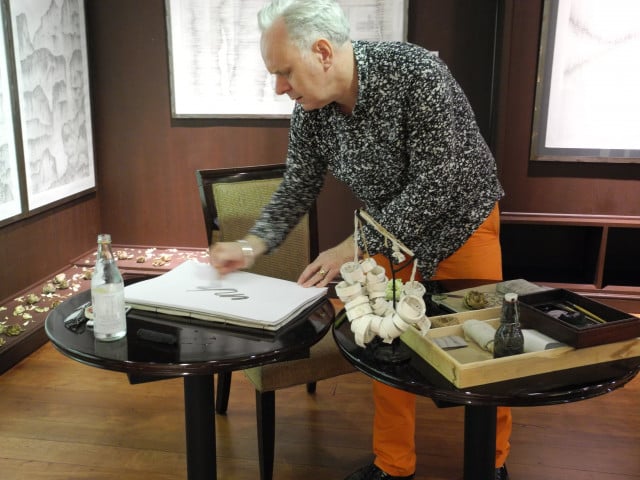Khmer Impressions: When Artworks Carry the Imprints of People’s Silent Appeals

- Michelle Vachon
- May 24, 2020 9:09 AM
An artist celebrates their pleas in black and white
PHNOM PENH--From the very start, Morrison Polkinghorne has meant his artworks to pay homage to a Cambodian custom.
An Australian living in Battambang City since 2014, he has watched for years people bring flowers to their Buddhist pagodas and wanted his work to reflect, in a discreet way, what they pray for as they leave their offerings: the appeals they make, the thank-yous they voice, and all the pain and joy reflected in the flowers they leave.
Polkinghorne also knew that, once the ceremonies are over and people have left, the Buddhist monks must remove the wilted flowers that can only be discarded.
So he developed a process for these flowers to become imprinted—literally—in artworks with all the emotions people placed in them while respecting their privacy.
A process that ended up taking an enormous amount of time.
And dedication.
The result is a series of imprints: discreet black marks shaping a landscape of mountains, tree trunks, flowers or simply waves on a white background, with an occasional touch of color.
They are now exhibited at the art gallery of the Sofitel Phnom Penh Phokeethra hotel in Phnom Penh.

The tools of Morrison Polkinghorne’s work: Dried flowers are turned into ashes that, with water, become a block of black color with which he can paint. Photo: provided by the artist
A painstaking process
Each artwork starts at the pagoda.
“The monks allow me to collect the flowers,” Polkinghorne said in interview. “Then I dry them, I burn them, I sit them in rainwater for 12 months. And then I have my ink [to which I] add fixative so that it actually sticks to the paper.
“My ink has the consolidation of hundreds of people’s gratitude and love,” he said. “So while I’m doing my work, the paintings, I do reflect on this.”
In each work, Polkinghorne counts the imprints he makes since each one represents the request or thank-you of a person who brought flowers to the pagoda. Then the number of imprints or points becomes part the work’s title.
“When I sign the work, I sign the work with [the number of] points. This piece here,” he said, indicating one of his works, “is a total of 450,629 dots. The completion of that other work here: 501,083 dots.”
Even the paper he uses—a special brand of paper meant for watercolor—has been selected with great care as a backdrop for these imprints, Polkinghorne said.

Morrison Polkinghorne uses a fresh green stalk to make each imprint in his artworks. Photo: provided by the artist.
An Artist and a craftsman
Polkinghorne’s profession has been to work with architects and designers handling luxury hotels, government buildings and special homes—including Kirribilli House, the Australian prime-minister’s official residence. He made the tassels that ornate the heavy curtains in halls or conference rooms. This required equipment especially designed to assemble fine silk and gold threads to create these curtain accessories, which must be both decorative and functional.
Specializing in 18th century French-tassel making in Australia had been no simple matter. “I had to make all my looms, I had to make tools, I had to develop the techniques,” Polkinghorne said. “I had to teach other people how to do this work. So I’ve always done art but my career was as an artisan.”
When he arrived in Battambang City in 2014, he opened the boutique hotel Bric-a-Brac with chef and award-winning cookbook author Robert Carmack, setting up a demonstration kitchen and curio shop on the ground floor, and his tassel-making equipment on the top one where he has worked with the Cambodian artisans he trained.
So Polkinghorne was used to meticulous work that takes days and weeks to complete when he embarked on creating artworks out of lotus-flower imprints.

Morrison Polkinghorne uses a fresh green stalk to make each imprint in his artworks. Photo: provided by the artist.
A unique and involved technique
In the process he developed, both the tools and ink come from flowers.
“This is another fun part: I make the ink, the ink goes onto a pad,” he said. “Then with this ink here, I get this accumulation of sooth. So from that sooth…that’s dried, this now becomes an ink cake and I’m able to make fresh ink and use this.”
With the ink ready, Polkinghorne can start his artworks. “When I put the ink on the ink pad, I use a fresh green lotus stalk to produce the marks, the impressions. I use a fresh green stalk to produce every single point, every single dot on these paintings.”
This is why he calls his work “Khmer Impressions,” he said, as each detail is printed with stalks of lotus flowers, which are so much part of the country’s tradition.
For Polkinghorne, the imperfection in an imprint is the reflection of people’s emotions it carries. “Every now and then, there is a little break in the stalk [which] works like a quill and sucks up the ink.
“So [the imprint made with that stalk] is not perfect,” he said. But it is the repetition of that faulty imprint that makes the work “human,” as it carries the diverse emotions of people of all ages.
“And when you get close to it, it actually starts to vibrate because of the metrics of the imperfections happening within the marks,” Polkinghorne said. “There’s a lot of recycling in there, you know: birth, growth, age, death, recycling, reincarnation.
“I’m able to do that with these flowers and then with the ink,” he added.
An artform becomes a quest
“I have a goal of five works,” Polkinghorne said. “My first of these five works will have one dot. So I’ll be working on that piece, it will have 1,000 – 10,000 dots. And within that piece, I will reach one million.
“And my second piece will have two dots [and will go up to] 2,000,002,” he said. The third work will go from three to 3,000,003 dots, the fourth one four to 4,000,004. And the last one will go from five to 5,000,005 dots.
“I estimated [it will take] 20 years of my life to create these five works,” Polkinghorne. “If it happens, it happens, if it doesn’t happen, it doesn’t happen: It’s good to have a goal. And I have a goal of five works.”
The exhibition at the gallery of the Sofitel Phnom Penh Phokeethra Hotel in Phnom Penh runs through the end of June.
Artist Morrison Polkinghorne in the gallery of the Sofitel Phnom Penh Phokeethra Hotel. Photo: Michelle Vachon
















